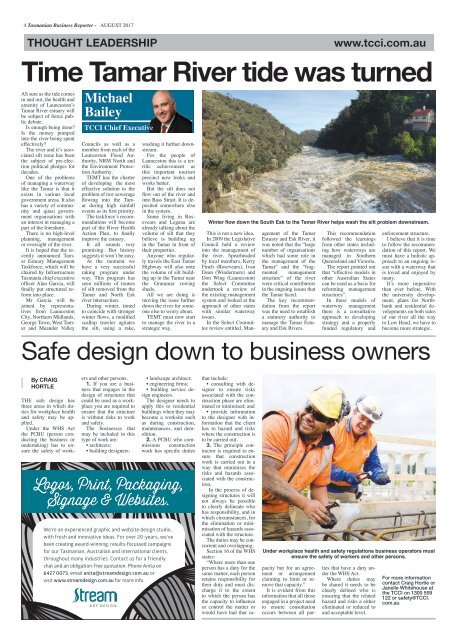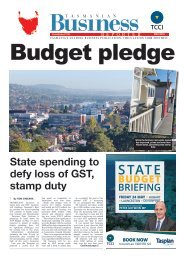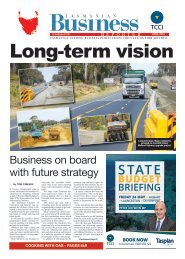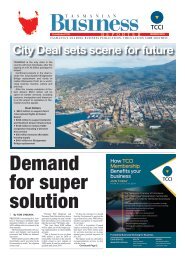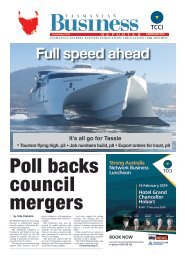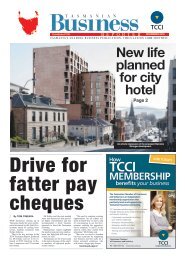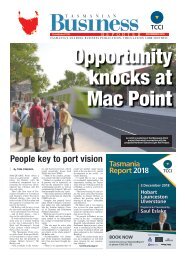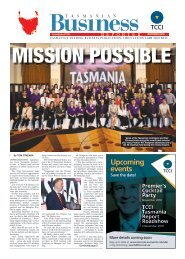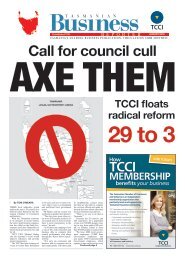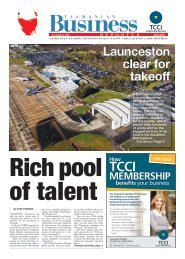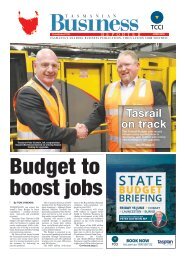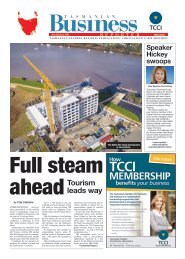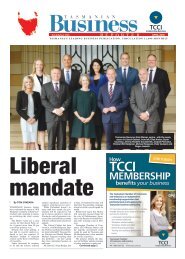Tasmanian Business Reporter August 2017
With the release of exciting new artist impressions, this month we discuss the $950 million in infrastructure projects currently on the table for the University of Tasmania. You can also read about the real life implications of social media in the workplace from our legal expert Abbey George, as well as news on the Japanese chefs highlighting Tasmania’s best produce and the professor putting sensors on bees.
With the release of exciting new artist impressions, this month we discuss the $950 million in infrastructure projects currently on the table for the University of Tasmania.
You can also read about the real life implications of social media in the workplace from our legal expert Abbey George, as well as news on the Japanese chefs highlighting Tasmania’s best produce and the professor putting sensors on bees.
You also want an ePaper? Increase the reach of your titles
YUMPU automatically turns print PDFs into web optimized ePapers that Google loves.
4 <strong>Tasmanian</strong> <strong>Business</strong> <strong>Reporter</strong> - AUGUST <strong>2017</strong><br />
THOUGHT LEADERSHIP<br />
www.tcci.com.au<br />
Time Tamar River tide was turned<br />
AS sure as the tide comes<br />
in and out, the health and<br />
amenity of Launceston’s<br />
Tamar River estuary will<br />
be subject of fierce public<br />
debate.<br />
Is enough being done?<br />
Is the money pumped<br />
into the river being spent<br />
effectively?<br />
The river and it’s associated<br />
silt issue has been<br />
the subject of pre-election<br />
political pledges for<br />
decades.<br />
One of the problems<br />
of managing a waterway<br />
like the Tamar is that it<br />
exists in various local<br />
government areas. It also<br />
has a variety of community<br />
and quasi government<br />
organisations with<br />
an interest in managing a<br />
part of the foreshore.<br />
There is no high-level<br />
planning, management<br />
or oversight of the river.<br />
It is hoped that the recently<br />
announced Tamar<br />
Estuary Management<br />
Taskforce, which will be<br />
chaired by Infrastructure<br />
Tasmania chief executive<br />
officer Alan Garcia, will<br />
finally put structured reform<br />
into place.<br />
Mr Garcia will be<br />
joined by representatives<br />
from Launceston<br />
City, Northern Midlands,<br />
George Town, West Tamar<br />
and Meander Valley<br />
Michael<br />
Bailey<br />
TCCI Chief Executive<br />
Councils as well as a<br />
member from each of the<br />
Launceston Flood Authority,<br />
NRM North and<br />
the Environment Protection<br />
Authority.<br />
TEMT has the charter<br />
of developing the most<br />
effective solution to the<br />
problem of raw sewerage<br />
flowing into the Tamar<br />
during high rainfall<br />
events as its first priority.<br />
The taskforce’s recommendations<br />
will become<br />
part of the River Health<br />
Action Plan, to finally<br />
improve the estuary.<br />
It all sounds very<br />
promising. But history<br />
suggests it won’t be easy.<br />
At the moment we<br />
have a very successful<br />
raking program under<br />
way. This program has<br />
seen millions of tonnes<br />
of silt removed from the<br />
Tamar and North Esk<br />
river intersection.<br />
During winter, timed<br />
to coincide with stronger<br />
winter flows, a modified<br />
scallop trawler agitates<br />
the silt, using a rake,<br />
washing it further downstream.<br />
For the people of<br />
Launceston this is a terrific<br />
achievement as<br />
this important tourism<br />
precinct now looks and<br />
works better.<br />
But the silt does not<br />
flow out of the river and<br />
into Bass Strait. It is deposited<br />
somewhere else<br />
in the system.<br />
Some living in Rosevears<br />
and Legana are<br />
already talking about the<br />
volume of silt that they<br />
believe is building up<br />
in the Tamar in front of<br />
their properties.<br />
Anyone who regularly<br />
travels the East Tamar<br />
Highway will also note<br />
the volume of silt building<br />
up in the Tamar near<br />
the Grammar rowing<br />
sheds.<br />
All we are doing is<br />
moving the issue further<br />
down the river for someone<br />
else to worry about.<br />
TEMT must now start<br />
to manage the river in a<br />
strategic way.<br />
Winter flow down the South Esk to the Tamar River helps wash the silt problem downstream.<br />
This is not a new idea.<br />
In 2009 the Legislative<br />
Council held a review<br />
into the management of<br />
the river. Spearheaded<br />
by local members, Kerry<br />
Finch (Rosevears), Ivan<br />
Dean (Windermere) and<br />
Don Wing (Launceston)<br />
the Select Committee<br />
undertook a review of<br />
the existing management<br />
system and looked at the<br />
approach of other states<br />
with similar waterway<br />
issues.<br />
In the Select Committee<br />
review entitled, Management<br />
of the Tamar<br />
Estuary and Esk River, it<br />
was noted that the “large<br />
number of organisations<br />
which had some role in<br />
the management of the<br />
Tamar” and the “fragmented<br />
management<br />
structure” of the river<br />
were critical contributors<br />
in the ongoing issues that<br />
the Tamar faced.<br />
The key recommendation<br />
from the report<br />
was the need to establish<br />
a statutory authority to<br />
manage the Tamar Estuary<br />
and Esk Rivers.<br />
This recommendation<br />
followed the learnings<br />
from other states including<br />
how waterways are<br />
managed in Southern<br />
Queensland and Victoria.<br />
The report pointed out<br />
that “effective models in<br />
other Australian States<br />
can be used as a basis for<br />
reforming management<br />
structures”.<br />
In these models of<br />
waterway management<br />
there is a consultative<br />
approach to developing<br />
strategy and a properly<br />
funded regulatory and<br />
enforcement structure.<br />
I believe that it is time<br />
to follow the recommendation<br />
of this report. We<br />
must have a holistic approach<br />
to an ongoing issue<br />
with a waterway that<br />
is loved and enjoyed by<br />
many.<br />
It’s more imperative<br />
than ever before. With<br />
the university development,<br />
plans for Northbank<br />
and residential developments<br />
on both sides<br />
of our river all the way<br />
to Low Head, we have to<br />
become more strategic.<br />
Safe design down to business owners<br />
By CRAIG<br />
HORTLE<br />
THE safe design has<br />
three areas in which duties<br />
for workplace health<br />
and safety may be applied.<br />
Under the WHS Act<br />
the PCBU (person conducting<br />
the business or<br />
undertaking) has to ensure<br />
the safety of work-<br />
ers and other persons.<br />
1. If you are a business<br />
that engages in the<br />
design of structures that<br />
could be used as a workplace<br />
you are required to<br />
ensure that the structure<br />
is without risks to work<br />
and safety.<br />
The businesses that<br />
may be included in this<br />
type of work are:<br />
• architects;<br />
• building designers;<br />
• landscape architect;<br />
• engineering firms;<br />
• building service design<br />
engineers.<br />
The designer needs to<br />
apply this to residential<br />
buildings when they may<br />
become a worksite such<br />
as during construction,<br />
maintenances, and demolition.<br />
2. A PCBU who commissions<br />
construction<br />
work has specific duties<br />
Under workplace health and safety regulations business operators must<br />
ensure the safety of workers and other persons.<br />
that include:<br />
• consulting with designer<br />
to ensure risks<br />
associated with the construction<br />
phase are eliminated<br />
or minimised; and<br />
• provide information<br />
to the designer with information<br />
that the client<br />
has to hazard and risks<br />
where the construction is<br />
to be carried out.<br />
3. The principle contractor<br />
is required to ensure<br />
that construction<br />
work is carried out in a<br />
way that minimises the<br />
risks and hazards associated<br />
with the construction.<br />
In the process of designing<br />
structures it will<br />
not always be possible<br />
to clearly delineate who<br />
has responsibility, and in<br />
which circumstances, for<br />
the elimination or minimisation<br />
of hazards associated<br />
with the structure.<br />
The duties may be concurrent<br />
and overlapping.<br />
Section 16 of the WHS<br />
states:<br />
“Where more than one<br />
person has a duty for the<br />
same matter, each person<br />
retains responsibility for<br />
their duty and must discharge<br />
it to the extent<br />
to which the person has<br />
the capacity to influence<br />
or control the matter or<br />
would have had that capacity<br />
but for an agreement<br />
or arrangement<br />
claiming to limit or remove<br />
that capacity.”<br />
It is evident from this<br />
information that all those<br />
engaged in a project need<br />
to ensure consultation<br />
occurs between all parties<br />
that have a duty under<br />
the WHS Act.<br />
Where duties may<br />
be shared it needs to be<br />
clearly defined who is<br />
ensuring that the related<br />
hazard and risks a either<br />
eliminated or reduced to<br />
and acceptable level.<br />
For more information<br />
contact Craig Hortle or<br />
Janelle Whitehouse at<br />
the TCCI on 1300 559<br />
122 or safety@TCCI.<br />
com.au


